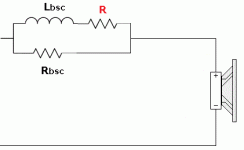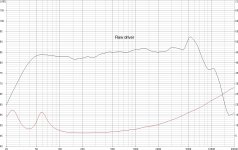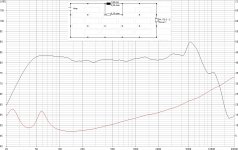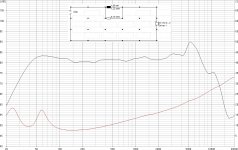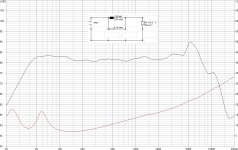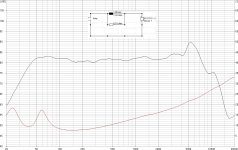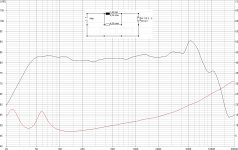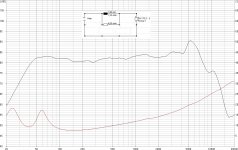Hi,
I'm planning to do a Baffle Step Compensation for my woofer. I calculated the values of BSC on the website and the website told me to use Rbsc = 6.1 ohms and an inductor(Lbsc) of 1.8 mH in parallel to make a BSC (image 1).
The problem is when I went to look at an inductor, the inductor was said it has a resistance about 1.22 ohms on it. So if I install all the components (image 2), Do I have to choose the value of Rbsc to compensate the effect from inductor's resistance ? and How is that value ?
Thank you.
I'm planning to do a Baffle Step Compensation for my woofer. I calculated the values of BSC on the website and the website told me to use Rbsc = 6.1 ohms and an inductor(Lbsc) of 1.8 mH in parallel to make a BSC (image 1).
The problem is when I went to look at an inductor, the inductor was said it has a resistance about 1.22 ohms on it. So if I install all the components (image 2), Do I have to choose the value of Rbsc to compensate the effect from inductor's resistance ? and How is that value ?
Thank you.
Attachments
This is not the good way to do BSC unless you have a 1-way speaker (aka fullrange). It is usually done oversizing the woofer inductor. See here for an example: Zaph|Audio and look at the transfer function.
Ralf
Ralf
This is not the good way to do BSC unless you have a 1-way speaker (aka fullrange). It is usually done oversizing the woofer inductor. See here for an example: Zaph|Audio and look at the transfer function.
Ralf
In my case, The woofer was used as a full range since it hasn't been connected to any networks and so the tweeter was used to take over at high frequencies where the woofer cannot go(~ 4 kHz).
Still you have to do a low pass filter (sort of).
You can download Speaker Workshop and see what the BSC circuit does, but I think that you need to minimize the DCR of the coil, else you'll loose sensitivity, I'd use a 0.22 Ohm coil and not a 1.22 Ohm one.
Ralf
You can download Speaker Workshop and see what the BSC circuit does, but I think that you need to minimize the DCR of the coil, else you'll loose sensitivity, I'd use a 0.22 Ohm coil and not a 1.22 Ohm one.
Ralf
That sounds like a 20 AWG air core or something. Use a good cored inductor, should be more like 0.15Ω.
In my case, The woofer was used as a full range since it hasn't been connected to any networks and so the tweeter was used to take over at high frequencies where the woofer cannot go(~ 4 kHz).
If you use that inductor, your bass response will change due to the high resistance, and you will have a fair amount of insertion loss. Qes and Qts both increase with added resistance in the inductor.
If the bass response change is not a deal breaker, and you liked the woofer/tweeter balance before, you will want to pad down the tweeter by whatever the insertion loss is in addition to the change required by your shelving filter.
Thanks a lot for all above answers but I still don't understand, sir. 🙁
I want to know if I want to build a BSC that require a 6.1 ohms resistor parallel with a 1.8 mH inductor. BUT in an inductor, there's some passive resistance of 1.22 ohms.
So, Should I have to replaced a 6.1 ohms resistor with a (approx) 4.88 ohms resistor to compensate it ??? 😕 (in order to make the whole resistance of this BSC's remains 6.1 ohms)
Note : The value 4.88 ohms comes from 6.1 - 1.22 ohms.
I want to know if I want to build a BSC that require a 6.1 ohms resistor parallel with a 1.8 mH inductor. BUT in an inductor, there's some passive resistance of 1.22 ohms.
So, Should I have to replaced a 6.1 ohms resistor with a (approx) 4.88 ohms resistor to compensate it ??? 😕 (in order to make the whole resistance of this BSC's remains 6.1 ohms)
Note : The value 4.88 ohms comes from 6.1 - 1.22 ohms.
No, it would be the other way (6.1+1.22), BUT don't use a 1.22Ω inductor if you're going to build that. For example: ERSE Super Q 1.8mH 16 AWG has a DCR of 0.137Ω.
The inductor I have is "Mundorf L71". (It's a 0.71mm wire, Air-core coil)
What do you think about it ? Should I use it or not ? If not, what jobs does this coil can be used ?
What do you think about it ? Should I use it or not ? If not, what jobs does this coil can be used ?
I habitually use 0.8mm inductors. Anything above 1mH, and it's laminate for this very reason. The amount of distortion induced by using a cored inductor is trivial compared to the insertion loss of an affordable air core or the price of a proper air core inductor. Let me put it like this: if you're worried about distortion, look at your drivers and enclosure before the coil of wire hooked up to the woofer. That is like putting clothes back in your drawer first when your house is hit by an earthquake.
You won't use a coil with a DCR so high in series with a woofer, it's best suited for a LCR trap (L+C+R in parallel with the driver), where the DCR has to be summed with a resistance of a resistor anyway.
For your application find a cored coil with DCR < 0.4 Ohm. Nothing fancy required.
Ralf
For your application find a cored coil with DCR < 0.4 Ohm. Nothing fancy required.
Ralf
The inductor I have is "Mundorf L71". (It's a 0.71mm wire, Air-core coil)
What do you think about it ? Should I use it or not ? If not, what jobs does this coil can be used ?
A good inductor. Mundorf rarely make poor quality components. But it's not really suitable for use as a series component on an LF driver (series R of a component & resistance paralleled with it are not quite the same thing). Like most other posters above, I would want something with a lower DCR. Either a 'manly' air-core (think 16ga / 1.4mm wound, minimum), or a good quality cored inductor. Don't sniff at the latter -there's nothing wrong with them if used properly.
Hi,
If you have the inductor use it. Your x/o is hardly refined
and its anybodies guess what resistor value, if any is
needed with your driver and the x/o to the tweeter.
Generally you'll get away with it with a low Q driver,
though it will affect the bass alignment somewhat.
rgds, sreten.
What bass/mid and what baffle width ?
If you have the inductor use it. Your x/o is hardly refined
and its anybodies guess what resistor value, if any is
needed with your driver and the x/o to the tweeter.
Generally you'll get away with it with a low Q driver,
though it will affect the bass alignment somewhat.
rgds, sreten.
What bass/mid and what baffle width ?
There is no series resistor, this is a low pass filter. If you need a resistor on the woofer, I'd get a more sensitive tweeter. 🙂I would subtract the DCR of the inductor from the value used for a series resistor and move on.
What he said. I initially used an air core coil in the bsc for my mltl speaker that was rated at 1 ohm dcr. It made the bass sound boomy. I replaced it with an erse iron core and the problem was solved. The 1 ohm resistance had raised the effective driver qts from .45 to .55.
Sent from my LS670 using Tapatalk 2
Sent from my LS670 using Tapatalk 2
Thanks a lot for all above answers but I still don't understand, sir. 🙁
This should clear any doubts. If you are not concerned about 1,22 dcr
of the coil and what it does to your bass response, go with it and 6,1 ohms
of bsc resistor. These simulations base upon using Visaton W170 S-8.
Lowering resistor value of bsc, lowers the effect of bsc filter.
Attachments
- Home
- Loudspeakers
- Multi-Way
- How to cope with a resistance of an inductor ?

